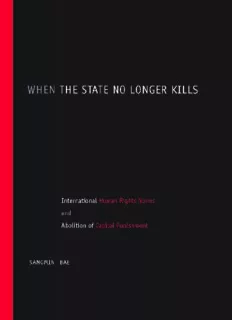
When the State No Longer Kills: International Human Rights Norms and Abolition of Capital Punishment PDF
Preview When the State No Longer Kills: International Human Rights Norms and Abolition of Capital Punishment
WHEN THE STATE NO LONGER KILLS SUNY SERIES IN HUMAN RIGHTS Zehra F. Kabasakal Arat, editor WHEN THE STATE NO LONGER KILLS International Human Rights Norms and Abolition of Capital Punishment SANGMIN BAE State University of New York Press Published by STATE UNIVERSITY OF NEW YORK PRESS, ALBANY © 2007 State University of New York All rights reserved Printed in the United States of America No part of this book may be used or reproduced in any manner whatsoever without written permission. No part of this book may be stored in a retrieval system or transmitted in any form or by any means including electronic, electrostatic, magnetic tape, mechanical, photocopying, recording, or otherwise without the prior permission in writing of the publisher. For information, contact State University of New York Press, Albany, NY www.sunypress.edu Production, Laurie Searl Marketing, Anne M. Valentine Library of Congress Cataloging-in-Publication Data Bae, Sangmin, 1971– When the state no longer kills : international human rights norms and abolition of capital punishment / Sangmin Bae. p. cm. — (Suny series in human rights) Includes bibliographical references and index. ISBN 978-0-7914-7207-1 (hardcover : alk. paper) 1. Capital punishment. 2. Human rights. I. Title. HV8694.B34 2007 364.66—dc22 2006037443 10 9 8 7 6 5 4 3 2 1 To my parents, who taught me how to live with passion CONTENTS List of Figures and Tables ix Foreword xi Preface xiii One INTRODUCTION: PROHIBITION OF THE DEATH PENALTY AS A HUMAN RIGHTS NORM 1 International Standards Prohibiting Capital Punishment 1 International Norms in International Relations Research 5 Methodological and Analytical Issues 12 Two UKRAINE 23 The Council of Europe and the Death-Penalty-Free Zone 24 Political Turbulence and Rising Crime Rates 29 Ukraine’s Resistance to the Council of Europe 32 Public Opinion on the Death Penalty Controversy 32 The Process of Enforcing the Council of Europe Norm 34 Conditions for Death Penalty Reform 36 Concluding Remarks 39 Three SOUTH AFRICA 41 Capital Punishment under Apartheid 42 The Abolitionist Movement and the Role of External Donors 45 The Moratorium on Executions 48 Political Transformation and Criminal Society: “Crime is Out of Control!” 51 The Constitutional Court’s Ruling on the Death Penalty 53 Post–Death Penalty Abolition Years: The Debate Continues 56 Who and What Played the Major Roles? 58 Conclusion: The Politics of Principle 60 CONTENTS viii Four SOUTH KOREA 63 Dictatorship, Economic Miracle, and Human Security (1948–1987) 65 Democratic Transition and the Continuing Use of the Death Penalty (1987–1997) 69 The Emergence of the Abolitionist Movement 70 Changing Political Conditions for Death Penalty Abolitionism (1998–Present) 72 The Abolitionist Camp: Catholic Church, Amnesty International, and Legislators 73 Why Not Abolition Right Now? 77 Concluding Remarks 83 Five UNITED STATES 85 “American Exceptionalism” and International Pressure 87 Do Crime Rates Matter? 91 The Vigilante Tradition 93 Racial Prejudice and Injustice 95 Why More after the 1980s?: The Era of Heightened Inequality and Punitiveness 96 Anti–Death Penalty Activism 97 Public Support for the Death Penalty: A Constant Variable 99 The Peculiarity of the U.S. Political Institutions 101 Is Political Leadership a Remaining Virtue? 105 Concluding Remarks 106 Six CONCLUSION 109 Ways of Norm Compliance: Ukraine, South Africa, South Korea, and the United States 110 Conditions for Norm Compliance 114 Causal Mechanisms of Norm Compliance 122 Conclusion: Extending the Argument 124 Notes 127 Bibliography 155 Index 173 FIGURES AND TABLES Figure 4.1 Number of Executions in South Korea, 1970–1997 67 Figure 5.1 Number of Executions in the United States, 1970–2005 89 Figure 5.2 Regional Distribution of Lynchings and Executions 94 Figure 6.1 Causal Mechanisms of Norm Adoption 122–123 Table 1.1 Cases: Different Stages of Norm Compliance 13 Table 1.2 Variables Categorized by Two Axes 14 Table 1.3 Summary of Variables 20 Table 2.1 Council of Europe’s Monitoring Procedure on the Death Penalty 26 Table 2.2 Criminality in Ukraine, 1972 and 1988–98 30 Table 3.1 South Africa’s Power-Sharing Government 50 Table 6.1 Pathways of Norm Compliance in Four Cases 123 ix
Description: